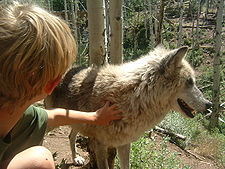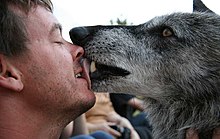
The wolf, also known as the gray wolf or grey wolf, is a large canine native to Eurasia and North America. More than thirty subspecies of Canis lupus have been recognized, including the dog and dingo, though gray wolves, as popularly understood, only comprise naturally-occurring wild subspecies. The wolf is the largest extant member of the family Canidae, and is further distinguished from other Canis species by its less pointed ears and muzzle, as well as a shorter torso and a longer tail. The wolf is nonetheless related closely enough to smaller Canis species, such as the coyote and the golden jackal, to produce fertile hybrids with them. The wolf's fur is usually mottled white, brown, gray, and black, although subspecies in the arctic region may be nearly all white.
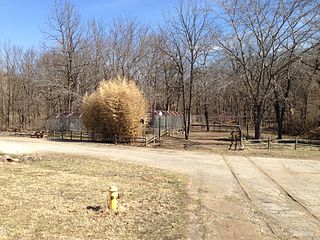
The Endangered Wolf Center is a non-profit wildlife facility in Eureka, Missouri, United States, near St. Louis that is dedicated to preserving and reintroducing to the wild critically endangered species of wolves. It is certified by the Association of Zoos and Aquariums (AZA). Visitors can tour the facility by making a reservation.

A wolfdog is a canine produced by the mating of a domestic dog with a gray wolf, eastern wolf, red wolf, or Ethiopian wolf to produce a hybrid.

Connecticut's Beardsley Zoo, located in Bridgeport, Connecticut, is the only Association of Zoos and Aquariums (AZA)-accredited zoo in the state of Connecticut. The zoo includes one of the few carousels in the state. The zoo has around 500 animals, from over 100 species, and welcomes about 280,000 visitors a year.

The Detroit Zoo is a zoo located in the cities of Huntington Woods and Royal Oak in the U.S. state of Michigan. Spanning 125 acres (50.6 ha), it houses more than 2,000 animals and more than 200 different species. The zoo was the first U.S. zoo to feature bar-less habitats, and is regarded to be an international leader in animal welfare, conservation and sustainability by the Detroit Zoological Society.
An animal rescue group or animal rescue organization is a group dedicated to pet adoption. These groups take unwanted, abandoned, abused, or stray pets and attempt to find suitable homes for them. Many rescue groups are created by and run by volunteers, who take animals into their homes and care for them—including training, playing, handling medical issues, and solving behavior problems—until a suitable permanent home can be found.

The Navajo Nation Zoological and Botanical Park is located in Window Rock, Arizona, the capital of the Navajo Nation. It is the only tribally owned zoological park in the United States and is notable among zoological facilities in that it labels its exhibits in the Native American Indian language of Navajo. Having been operated by the Navajo Nation Parks & Recreation Department since its inception in the early 1960s, it became part of the Navajo Nation Department of Fish and Wildlife in September 2006.
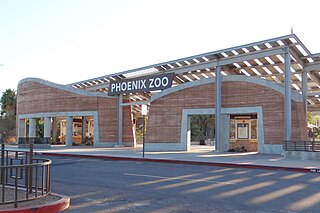
The Phoenix Zoo opened in 1962 and is the largest privately owned, non-profit zoo in the United States. Located in Phoenix, Arizona, the zoo was founded by Robert Maytag, a member of the Maytag family, and operates on 125 acres (51 ha) of land in the Papago Park area of Phoenix. It has been designated as a Phoenix Point of Pride.
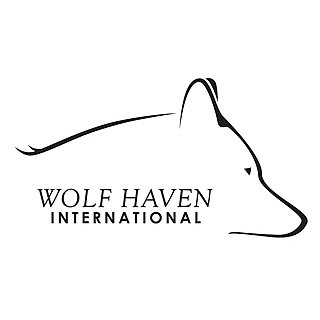
Wolf Haven International, previously known as Wolf Country and Wolf Haven America, is a wolf sanctuary and 501(c)(3) non-profit organization headquartered in Tenino, Washington. Founded in 1982 by Steve and Linda Kuntz, the organization provides educational programs on wolves, engages in wolf-related activism, and operates as a sanctuary for displaced, captive-born wolves. It also fosters and participates in captive-breeding programs for two highly endangered types of wolves: the red wolf and the Mexican wolf. Wolf Haven is one of three facilities in the United States that provides pre-release housing for Mexican gray wolves bred for Southwest restoration programs.

An animal sanctuary is a facility where animals are brought to live and to be protected for the rest of their lives. Pattrice Jones, co-founder of VINE Sanctuary defines an animal sanctuary as "a safe-enough place or relationship within the continuing hazards that menace everybody". In addition, sanctuaries are an experimental staging ground for transformative human–animal relations. There are five types of animal sanctuaries reflective of the species-belonging of the residents: 1) companion animal sanctuaries; 2) wildlife sanctuaries; 3) exotic animal sanctuaries; 4) farmed animal sanctuaries; and 5) cetacean sanctuaries.

Carolina Tiger Rescue is a nonprofit wildcat sanctuary in Pittsboro, North Carolina, that offers public tours and field trips and is home to rescued tigers, lions, cougars, leopards, caracals, servals, bobcats and other wild animals. Over 20,000 visitors come to the sanctuary each year for guided tours, field trips, summer camps, volunteering and corporate work groups. Their mission is saving and protecting wild cats in captivity and in the wild. They work toward a day when wild cats are living in their native habitat and are not exploited by humans. Carolina Tiger Rescue is Global Federation of Animal Sanctuaries (GFAS) and USDA accredited. The Executive Director is Kris Marino.
Shaun Ellis is a British animal researcher who lived among wolves, and adopted a pack of abandoned North American timber wolf pups. He is the founder of Wolf Pack Management and is involved in a number of research projects in Poland and at Yellowstone National Park in the United States.
Wild Spirit Wolf Sanctuary (WSWS) is an animal sanctuary in Candy Kitchen, New Mexico, United States, dedicated to rescuing and providing sanctuary for captive-bred wolves, wolfdogs and other canids. It is a 501(c)(3) non-profit organization and the largest canid sanctuary in all of North America.

Niabi Zoo is a public Zoological Park in Coal Valley, Illinois, serving the Quad Cities Area. This 40 acre zoo is nestled inside its 287 acre forest preserve. The exploration of this picturesque setting guides guests through the discovery of more than 600 animals representing nearly 200 animal species from around the world. Niabi Zoo is open for general admission April–October annually and offers robust education and outreach programs year round.
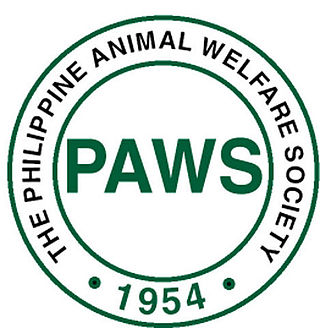
The Philippine Animal Welfare Society (PAWS) is a volunteer-based, non-government organization whose goal is to prevent animal cruelty through education, animal sheltering and advocacy, based in Quezon City, Philippines. It was founded in 1954 by Muriel Jay. PAWS believes that the creation of a more peaceful society starts with the widening of mankind's circle of compassion which includes animals, thereby envisions a nation that respects animals, practices responsible pet ownership and protects wildlife. The volunteer-based organization rehabilitates these animals in the hope of finding them new homes and a second chance at a good life. PAWS does not take in pets of other people, but only victims of cruelty or neglect where the animal offenders are charged with violation of the Animal Welfare Act in court.

Wolves are sometimes kept as exotic pets, and in some rarer occasions, as working animals. Although closely related to domesticated dogs, wolves do not show the same tractability as dogs in living alongside humans, and generally, a greater amount of effort is required in order to obtain the same amount of reliability. Wolves also need much more space than dogs, about 25 to 40 square kilometres so they can exercise.

Wolf hunting with dogs is a method of wolf hunting which relies on the use of hunting dogs. While any dog, especially a hound used for hunting wolves may be loosely termed a "wolfhound", several dog breeds have been specifically bred for the purpose, some of which, such as the Irish Wolfhound, have the word in their breed name.

The Wild Animal Sanctuary is a 1,214-acre (491 ha) animal sanctuary in Keenesburg, Colorado, United States. The sanctuary specializes in rescuing and caring for large predators which are being ill-treated, for which their owners can no longer care, or which might otherwise be euthanized. It is a 501(c)(3) nonprofit organization and a state and federally licensed zoological facility.

A free-ranging dog is a dog that is not confined to a yard or house. Free-ranging dogs include street dogs, village dogs, stray dogs, feral dogs, etc., and may be owned or unowned. The global dog population is estimated to be 900 million, of which around 20% are regarded as owned pets and therefore restrained.

Give Our Strays A Chance (GOSAC) is an organisation founded in 2013 by a Western Australian 10-year-old boy Dean Morris, for the purpose of raising awareness of animal rescue and raising donations for animal shelters and pounds.



